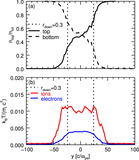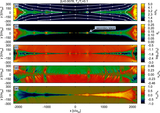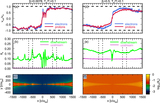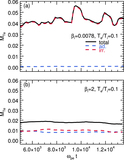Image Details
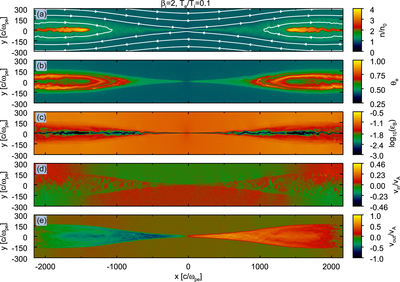
Caption: Figure 6.
2D structure at ﹩t=11250\,{\omega }_{\mathrm{pe}}^{-1}\approx 0.75\,{t}_{{\rm{A}}}﹩ from a representative high-﹩{\beta }_{{\rm{i}}}﹩ simulation (A[4] in Table 1) with ﹩{\beta }_{{\rm{i}}}=2﹩, ﹩{\sigma }_{w}=0.1﹩, ﹩{T}_{{\rm{e}}}/{T}_{{\rm{i}}}=0.1﹩, and ﹩{m}_{{\rm{i}}}/{m}_{{\rm{e}}}=25﹩ (i.e., apart from ﹩{\beta }_{{\rm{i}}}﹩, with the same parameters as in Figure 5). The panels show the same quantities as in Figure 5. As shown in panel (a), the density is roughly ﹩n/{n}_{0}\approx 1.2﹩ in the bulk of the outflow, which is only slightly larger than the upstream density. In the primary island, the density reaches ﹩n/{n}_{0}\approx 4.﹩ The electron temperature (panel (b)) is nearly uniform in the reconnection exhausts (i.e., within a distance of ﹩\approx 700\,c/{\omega }_{\mathrm{pe}}﹩ from the central X-point), with ﹩{\theta }_{{\rm{e}}}\approx 0.6﹩. Within the primary island, the temperature reaches ﹩{\theta }_{{\rm{e}}}\approx 0.8.﹩ In panel (c), we present the logarithm of magnetic energy fraction ﹩{\varepsilon }_{B}﹩, showing that the reconnection layer is weakly magnetized (﹩{\varepsilon }_{B}\lesssim 0.01﹩). Panel (d) shows that the inflow velocity is nearly uniform in the upstream, with a typical value ﹩| {v}_{\mathrm{in}}| /{v}_{{\rm{A}}}\approx 0.04.﹩ Panel (e) shows that the outflow velocity in the reconnection exhausts is ﹩| {v}_{\mathrm{out}}| /{v}_{{\rm{A}}}\approx 0.6﹩. At the center of the primary island, ﹩x\approx \pm 2200c/{\omega }_{\mathrm{pe}},﹩ the plasma from the reconnection outflows comes to rest, ﹩| {v}_{\mathrm{out}}| /{v}_{{\rm{A}}}\approx 0﹩.
Copyright and Terms & Conditions
© 2017. The American Astronomical Society. All rights reserved.





